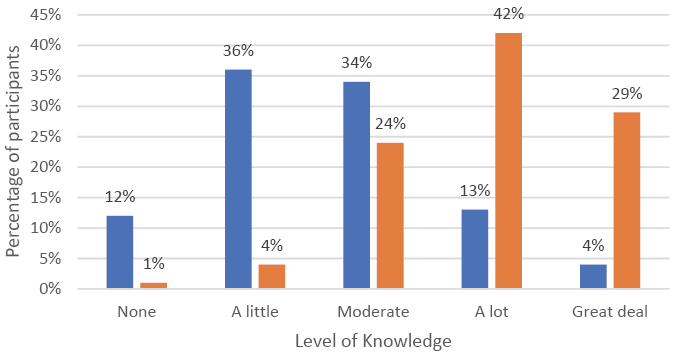The webinar series had more than 3,000 in-person participants from eight countries and the recordings have had more than 400 views. Participant survey data demonstrated that 90% of attendees agreed or strongly agreed that they learned what they expected (Figure 1).
Figure 1. Intersection of the Cattle and Beef Industries. Did you learn what you expected? Participant data from 15 sessions.
Surveys also indicated that producer knowledge significantly increased from prior to attending webinars to after receiving education. Before programming, 17% of attendees rated their topic knowledge as “a lot” or a “great deal,” and after the webinar sessions, 81% of attendees rated their knowledge as “a lot” or a “great deal” (Figure 2). Attendees reported using the information taught on the webinars to make more educated business and policy decisions and several who were members of state legislatures stated they used the information to be more informed when developing or deciding on legislation impacting the beef industry.
Figure 2. Participant Knowledge Before and After Attending Intersection of the Cattle and Beef Industries
The webinar series is archived for future viewing at www.ag.ndsu.edu/livestockextension/intersectionwebinars.
Feedback on the webinar series:
- “I don’t know if you could do a greater service to the industry and the subject than these webinars. Thank you so much.”
- “Never have I ever participated in such a comprehensive, 360° view of the beef and cattle industry. While being involved in many facets of beef cattle production, my eyes were opened to the many components, features, qualities and obstacles that brings beef from pasture to plate. I have shared the processes, facts and knowledge I have learned with other industry individuals, and have suggested to many young adults the time invested into this webinar is worth its weight in gold as they get a foothold on their place in this industry’s future!”
- “I was fortunate to attend most of the webinars in the Intersection of Cattle and Beef series. Following are my observations related to the utility of this series for U.S. beef producers:
- The series was very timely. The U.S. beef industry had experienced two black swan events in less than eight months – The Tyson beef plant fire in August 2019 and the COVID pandemic. Both impacted the beef industry by disrupting the harvest and distribution of beef. This disruption immediately impacted cattle prices and compromised the profitability/sustainability of many operations.
- The webinar series was informative, especially for cow-calf producers and those lacking experience in the feeding, harvesting and distribution segments of the beef industry. Participants were allowed virtual ‘behind the scenes’ visits to harvest facilities and visits with those in the business of distributing and merchandizing beef. The better one understands the entire industry, the more effective they become at managing their segment and the product(s) there from.
- By increasing knowledge and understanding of other segments of the industry, the webinar series relieved some of the distrust cow-calf felt for other segments of the industry. Record large packer margins frequented industry news outlets, while profit margins in all other segments of the industry shrunk or went negative. The webinar series masterfully explained profit margins and contributors to the magnitude of these margins.“
- “As a state legislator, I used the information on the mandatory price reporting, formula pricing and price discovery. This webinar gave me a better understanding of what all was included and meant by the 30/14 50/14. It allows me to better make a decision on it!”
- “This course should be mandatory for every college student enrolled in agriculture.”
- “I can hardly stand the wait for Tuesday and Thursday nights now! I know this is for producers but consumers can learn a lot too! - retired electrical engineer with zero agricultural experience except eating food from Texas”

